PONTIAC GRAND-AM 1996 Manual PDF
Manufacturer: PONTIAC, Model Year: 1996, Model line: GRAND-AM, Model: PONTIAC GRAND-AM 1996Pages: 356, PDF Size: 17.17 MB
Page 71 of 356
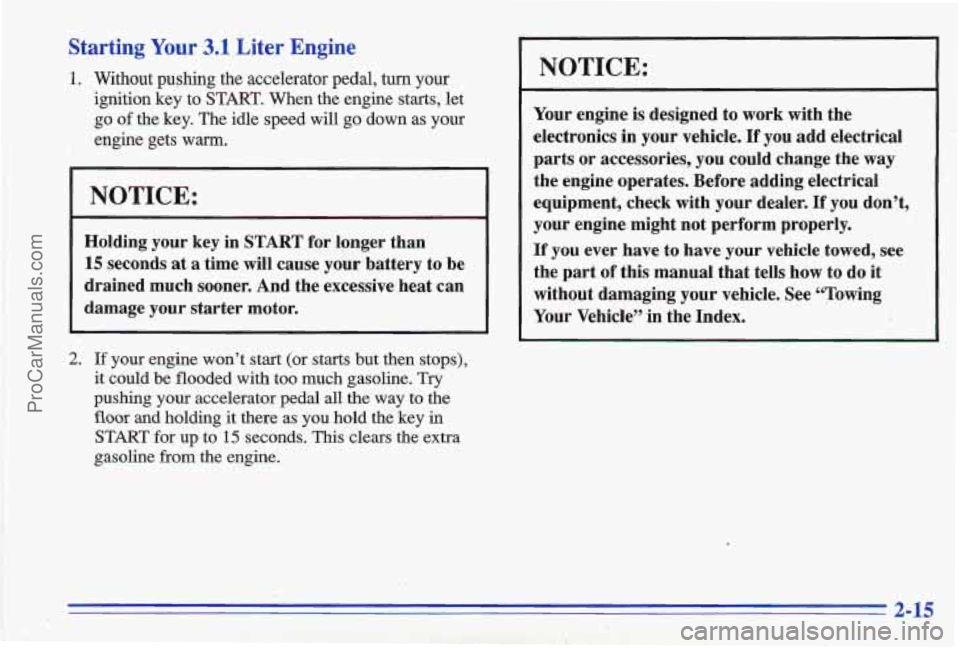
Starting Your 3.1 Liter Engine
1. Without pushing the accelerator pedal, turn your
ignition key to START. When the engine starts, let
go of the key. The idle speed will go down as your
engine gets warm.
NOTICE:
Holding your key in START for longer than
15 seconds at a time will cause your battery to be
drained much sooner. And the excessive heat can
damage your starter motor.
2. If your engine won’t start (or starts but then stops),
it could be flooded with too much gasoline.
Try
pushing your accelerator pedal all the way to the
floor and holding it there as you hold the key in
START for up to 15 seconds, This clears the extra
gasoline from the engine.
NOTICE:
Your engine is designed to work with the
electronics in your vehicle.
If you add electrical
parts or accessories, you could change the way
the engine operates. Before adding electrical
equipment, check with your dealer.
If you don’t,
your engine might not perform properly.
If you ever have to have your vehicle towed, see
the part of this manual that tells how to do it
without damaging your vehicle. See “Towing
Your Vehicle” in the Index.
ProCarManuals.com
Page 72 of 356
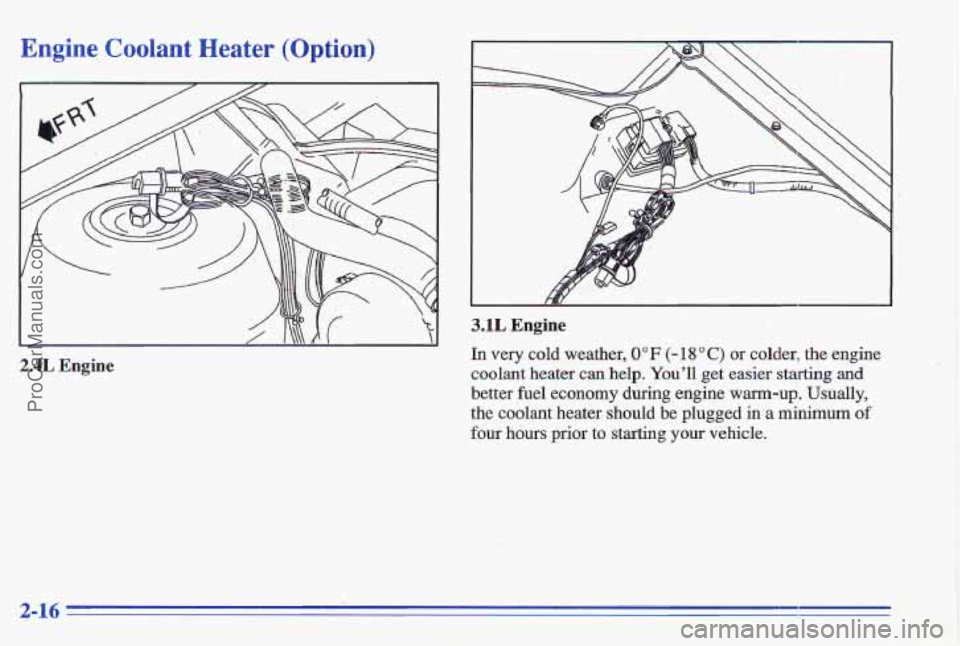
Engine Coolant Heater (Option)
2.4L Engine
c
c
I RI
3.1L Engine
In very cold weather, 0°F (- 18°C) or colder, the engine
coolant heater can help. You’ll get easier starting and
better fuel economy during engine warm-up. Usually,
the coolant heater should be plugged
in a minimum of
four hours prior to starting your vehicle.
2-16
ProCarManuals.com
Page 73 of 356
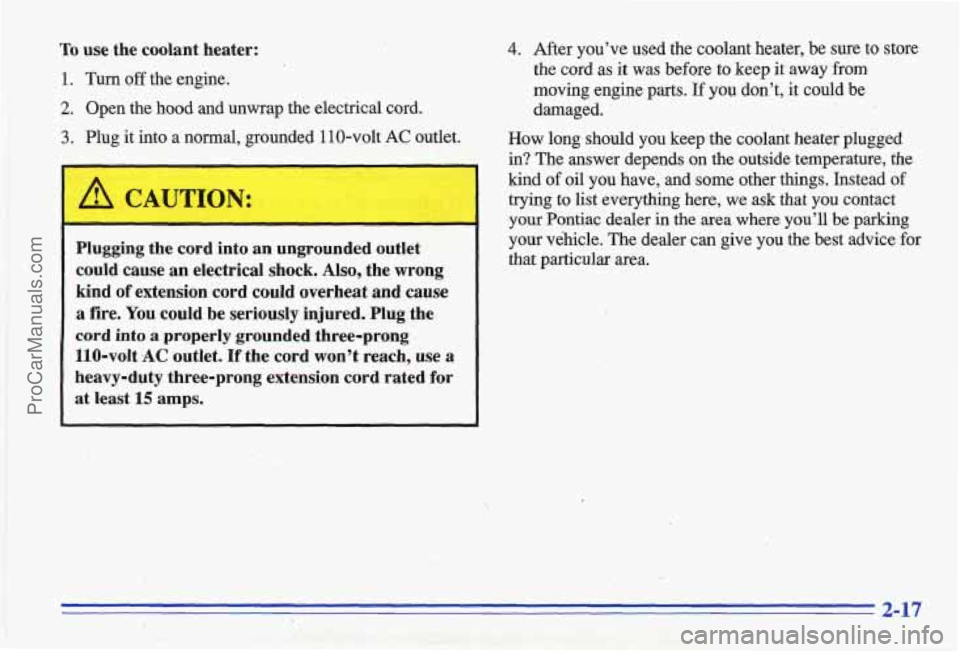
To use the coolant heater:
1. Turn off the engine.
2. Open the hood and unwrap the electrical cord.
3. Plug it into a normal, grounded 110-volt AC outlet.
1 A CAUTION:
Plugging the cord into an ungrounded outlet
could cause an electrical ,shock. Also, the wrong
kind
of extension cord could overheat and cause
a fire. You could be seriously injured. Plug the
cord into
a properly grounded three-prong
110-volt
AC outlet. If the cord won't reach, use a
heavy-duty three-prong extension cord rated for
at least 15 amps.
,-.. . . . 4.8 ..
4. After you've used the coolant heater, be sure to store
the cord as it was before
to keep it away from
moving engine parts. If you don't, it could be
damaged.
How long should you keep$he coolarit heater plugged
in? The answer depends on the outside temperature,
the
kind of oil you have, and some other things. Instead of
trying to list everything here, we
ask that you contact
yo" Pontiac dealer in the area where you'll be parking
your vehicle. The dealer can give you the best advice for
that particular area.
.. . i
ProCarManuals.com
Page 74 of 356
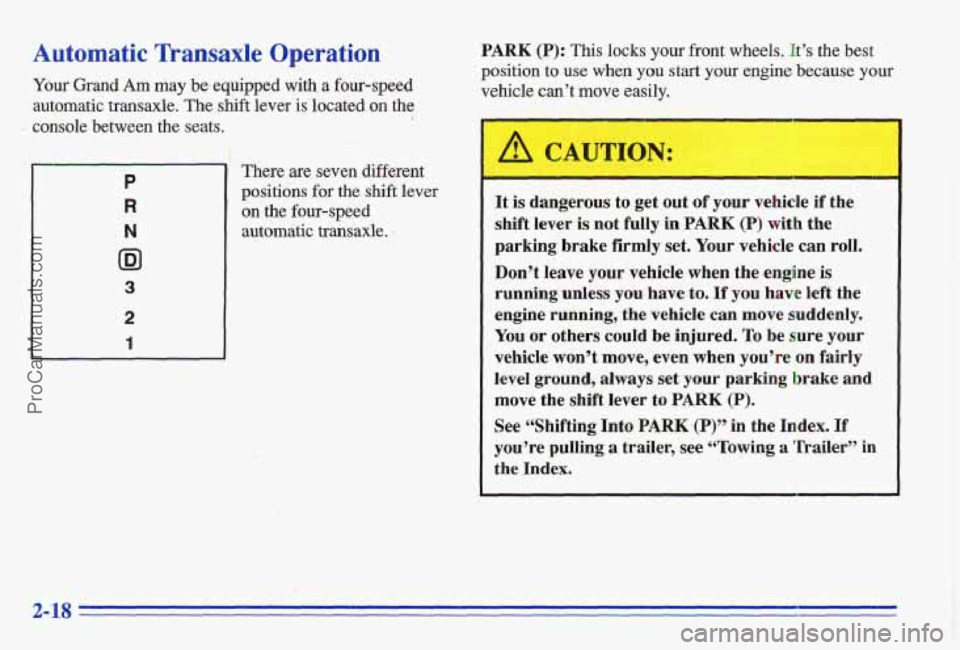
Automatic Transaxle Operation
Your Grand Am may be.equipped with a four-speed
automatic transaxle. The shift lever
is located on the
console between the seats. i
P
R
N
ID1
3
2
1
There are seven different
positions
for the shift lever
on the four-speed
autom&ic transaxle.
PARK (P): This locks your front wheels. It’s the best
position to use when you start your engine because your
vehicle can’t move easily.
It is dangerous to get out of your vehicle if the
shift lever
is not fully in PARK (P) with the
parking brake firmly set. Your vehicle can roll.
Don’t leave your vehicle when the engine is
running unless you have to, If you have left the
engine running, the vehicle can move suddenly.
You or others could be injured. To be sure your
vehicle.won’t move, even when
you’re on fairly
level ground, always set your parking brake and
move the shift lever to PARK (P).
See &‘Shifting Into PARK,(P)” in the Index, Tf
you’re pulling a trailer, see “Towing a in
the Index.
2- 18
ProCarManuals.com
Page 75 of 356
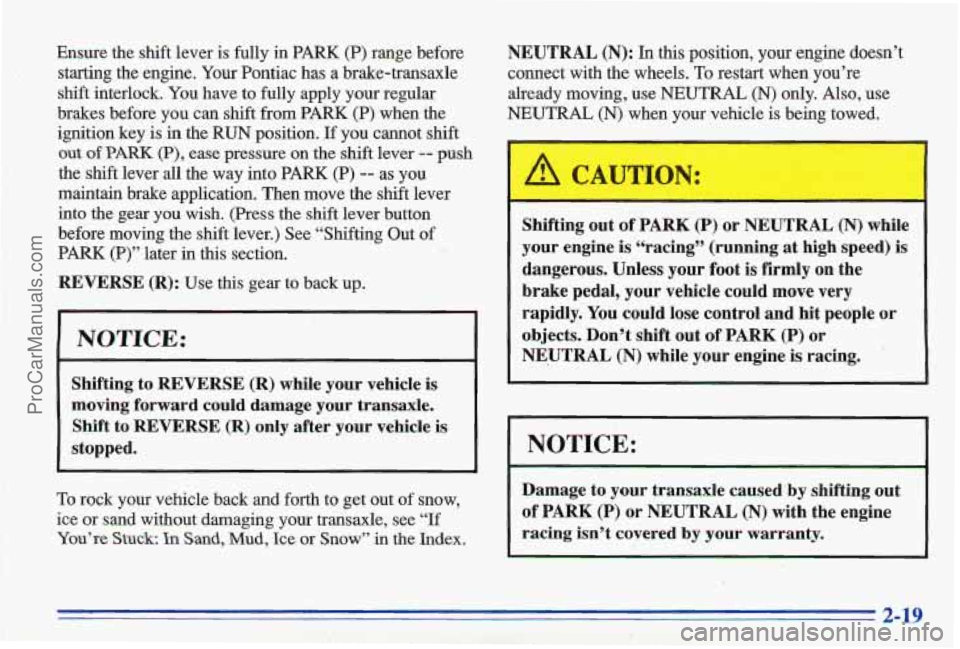
I
Ensure the shift lever is fully in PARK (P) range before
1 ’. I . starting the engine. Your Pontiac has a brake-transaxle !’ 2 . shift interlock. You have to fully apply your regular
brakes before you can shift from PARK (P) when the
ignition key is in the
RUN position. If you cannot shift
out of PARK (P), ease pressure on the shift lever -- push
the shift lever all the way into PARK
(P) -- as you
maintain brake application. Then move the shift lever
into the gear you wish. (Press the shift lever button
before moving the shift lever.) See “Shifting Out
of
PARK (I?)” later in this section.
REVERSE (R):
Use this gear to back up.
NOTICE:
Shifting to REVERSE (R) while your vehicle is
moving forward could damage
your transaxle.
Shift to REVERSE (R) only after your vehicle
is
stopped.
To rock your vehicle back and forth to get out of snow,
ice or sand without damaging your transaxle, see
“If
You’re Stuck: In Sand, Mud, Ice or Snow” in the Index. NEUTRAL
(N):
In this position, your engine doesn’t
connect with the wheels.
To restart when you’re
already moving, use
NEUTRAL (N) only. Also, use
NEUTRAL (N) when your vehicle is being towed.
I
Shifting out of PARK (P) or NEUTRAL (N) while
your engine
is “racing” (running at high speed) is
dangerous. Unless your foot is firmly on. the
brake pedal, your vehicle could move very
rapidly.
You could lose control and hit people or
objects. Don’t shift out of PARK
(P) or
NEUTRAL
(N) while your engine is racing. .
NOTICE:
Damage to your transaxle caused’by shifting ‘out
of PARK
(P) or NEUTRAL (N) with the engine
racing isn’t covered
by your warranty.
ProCarManuals.com
Page 76 of 356
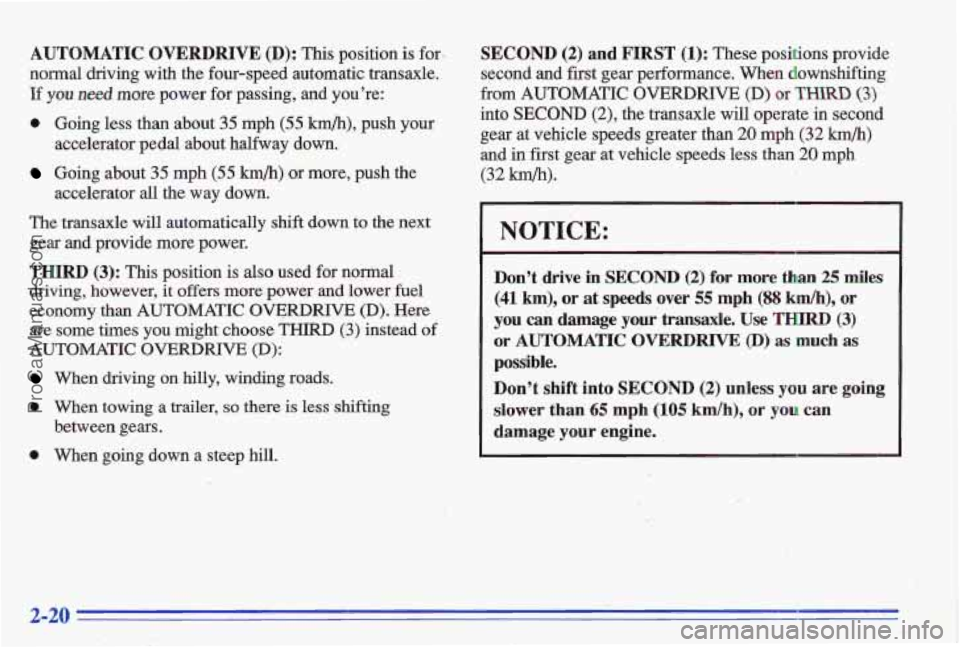
AUTOMATIC OVERDRIVE (D): This position is for-
normal driving with the four-speed automatic transaxle.
If
you need more power for passing, and you’re:
0 Going less than about 35 mph (55 km/h), push your
Going about 35 mph (55 km/h) or more, push the
The transaxle will automatically shift down to the next gear
and provide more power.
THIRD (3): This position is also used for normal
driving, however, it offers more power and lower fuel
economy than AUTOMATIC OVERDRIVE (D). Here
are some times you might choose THIRD (3) instead of
AUTOMATIC OVERDRIVE (D):
When driving on hilly, winding roads.
0 When towing a trailer, so there is less shifting
0 When going down a steep hill,
accelerator
pedal about halfway down.
accelerator
all the way down.
between
gears.
SECOND (2) and FIRST (1): These positions provide
second and first gear performance. When downshifting
from AUTOMATIC OVERDRIVE (D) or THIRD (3)
into SECOND (2), the transaxle will operate in second
gear at vehicle speeds greater than 20 mph (32 km/h)
and in first gear at vehicle speeds less than 20 mph
(32 km/h).
_. .
NOTICE:
Don’t drive in SECOND (2) for more than 25 miles
(41 km), or at speeds over 55 mph (88 kdh), or
you
can damage your transaxle. Use THIRD (3)
or AUTOMATIC OVERDRIVE (D) as much as
possible,
Don% shift into SECOND
(2) unless you are going
slower than 65 rnph (109 kmh), or you can
damage your engine.
...
.’. ’ ir ’
2-20
ProCarManuals.com
Page 77 of 356
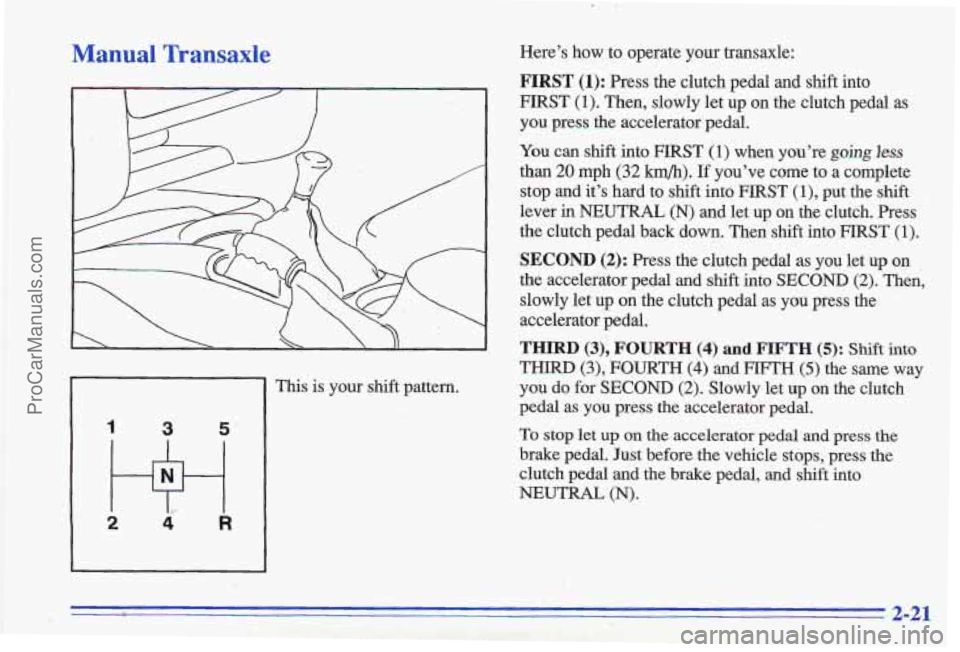
Manual Transaxle
1 3 5’
2 Hi 4 R
This is your shift pattern.
.. .- . 2;.
Here’s how to operate your transaxle:
FIRST (1): Press the clutch pedal and shift into
FIRST (1). Then, slowly let up on the clutch pedal
as
you press the accelerator pedal.
You can shift into FIRST
(1) when you’re going less
than 20 mph (32 km/h). If you’ve come to a complete
stop and it’s hard to shift
into FIRST (1)’ put the shift
lever
in NEUTRAL (N) and let up on the clutch. Press
the clutch pedal back down. Then shift into FIRST (1).
SECOND (2): Press the clutch pedal as you let up on
the accelerator pedal and shift into
SECOND (2). Then,
slowly let up
on the clutch pedal as you press the
accelerator pedal.
THIRD (3), FOURTH (4) and FIFTH (5): Shift into
THIRD
(3), FOURTH (4) and FIFTH (5) the same way
you do for
SECOND (2). Slowly let up on the clutch
pedal as you press the accelerator
pedal.
To stop let up on the accelerator pedal and press the
brake pedal. Just before the vehicle stops, press the
clutch pedal and the brake pedal, and shift into
NEUTRAL (N).
ProCarManuals.com
Page 78 of 356
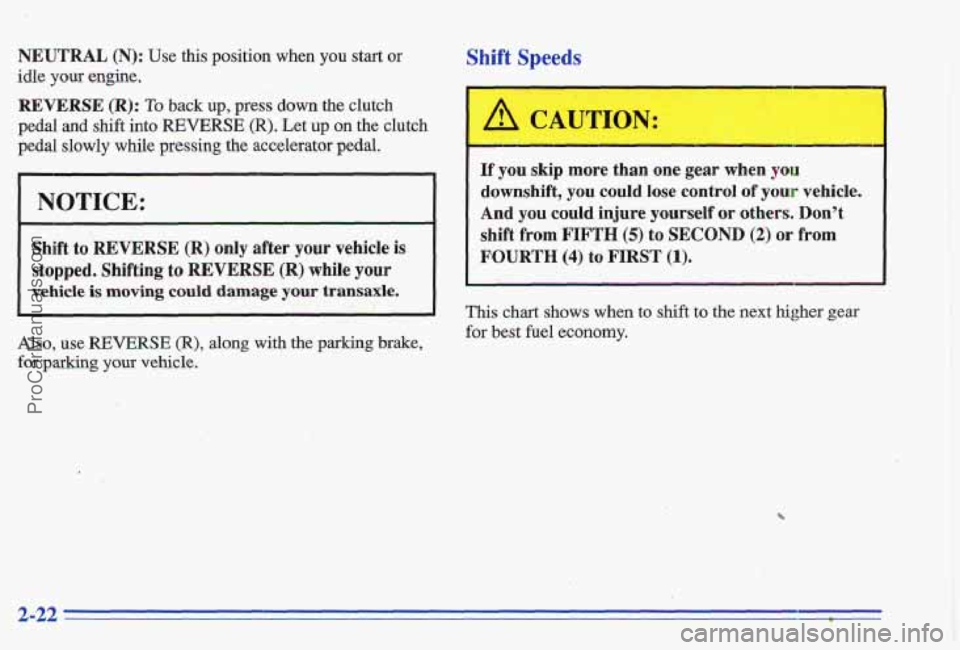
NEUTRAL '(N): Use this position when you start or
idle your engine.
REVERSE (R): To back up, press down the clutch
pedal and shift into REVERSE (R). Let up on the clutch
pedal slowly
while pressing the accelerator pedal.
'1 NOTICE:
Shift to REVERSE (R) only after your vehicle is
stopped. Shifting to REVERSE (It) while your
vehicle is moving could damage your transaxle.
..
1
Also, use WVERSE (R), along with the parking brake,
for parking your vehicle.
Shift Speeds
I A CAUTION:
If you skip more than one gear when you
downshift, you could lose control of your vehicle.
And you could injure yourself or others. DonY
shift from
FIFTH (5) to SECOND (2) or from
FOURTH (4) to FIRST (1).
This chart shows when to shift to the next higher gear
for best
fuel economy.
ProCarManuals.com
Page 79 of 356
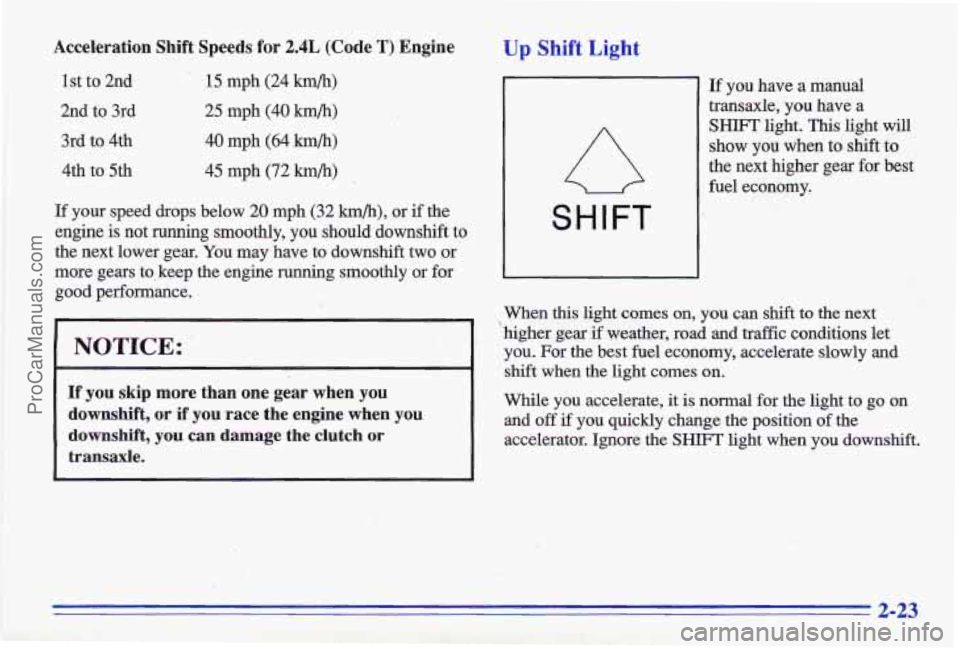
Acceleration Shift Speeds for 2.4L (Code T) Engine
1st to 2nd 15 mph (24 krn/h)
2nd to 3rd 25 mph (40 krn/h)
3rd to 4th 40 mph (64 h/h)
4th to 5th 45 mph (72 km/h)
If your speed drops below 20 mph (32 lun/h), or if the
engine is not running smoothly, you should downshift to
the next lower gear. You may have to downshift two or
more gears
to, keep the engine running smoothly or for
good performance.
NOTICE:
If you skip more than one gear when you
downshift, or if you race the engine when you
downshift, you can damage the clutch or
transaxle.
Up Shift Light
SHIFT
If you have a manual
transaxle, you have a
SHIFT light. This light will
show you when to
shift to
the next higher gear for best
fuel economy.
When this light comes on, you can shift
to the next
higher gear
if weather, road and traffic conditions let
you. For the best fuel economy, accelerate slowly and
shift when the light comes on.
\,
While you accelerate, it is normal for the light to go on
and off if you quickly change the position of the
accelerator. Ignore the
SHIFT light when you downshift.
2-23
ProCarManuals.com
Page 80 of 356

Parkiaag.’Brake handle. If the ignition is on, the brake system warning
light will come on.
To release the parking brake hold the regular brake
pedal down. Pull
the parking brake lever up until you
can press the release button. Hold the release button in
as you move the brake lever all the way down.
Driving with the parking, brake on can cause
your rear brakes to overheat. You may have to
replace them, and you could also damage other
To set the parking brake hold the .regular brake pedal If you are towing a trailer and are parking on my hill,
see “Towing
a Trailer” in the Index. That section shows
down with Your ‘ght foot* On the parking brake what to do first to keep the bailer from moving.
2-24
ProCarManuals.com